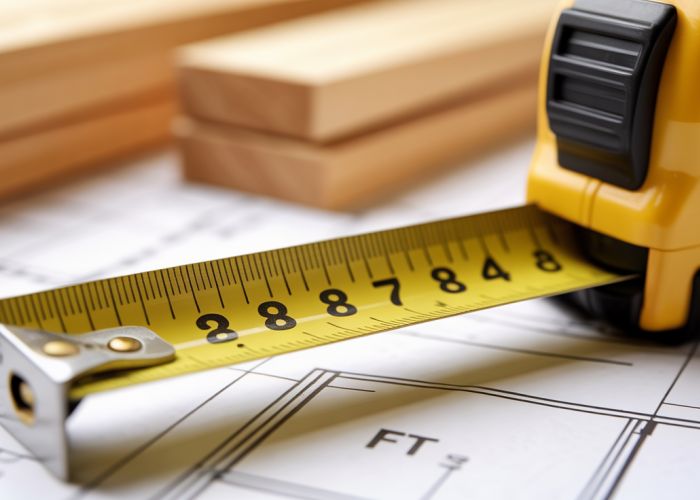Construction projects frequently rely on precise measurements, and understanding the linear feet abbreviation becomes essential for accuracy. Carpentry, for instance, uses lf, a common linear feet abbreviation, to determine material requirements for baseboards and trim. The National Institute of Standards and Technology (NIST) provides guidelines that influence how professionals within real estate and other industries correctly use this unit of measurement in their calculations.

Understanding and Using the Linear Feet Abbreviation
This guide offers a comprehensive understanding of the linear feet abbreviation, its variations, and best practices for its use. Accurate and consistent abbreviation is crucial for clear communication in various fields, including construction, real estate, and DIY projects.
What is Linear Feet?
Before diving into the abbreviations, it’s essential to define what linear feet represents.
- Linear feet is a unit of measurement used to express length in one dimension.
- It represents the length of a straight line, without considering width or height.
- Think of it as the distance you would travel in a straight line along an object, such as a piece of lumber, a fence, or a roll of fabric.
Linear Feet vs. Square Feet vs. Cubic Feet
It’s vital to distinguish linear feet from other common measurements.
- Square Feet (sq ft or ft²): Measures area (length x width). Used for measuring floor space, wall area, or the surface area of a sheet of material.
- Cubic Feet (cu ft or ft³): Measures volume (length x width x height). Used for measuring the capacity of containers or the amount of material needed to fill a space.
Understanding these differences is key to using the correct units and abbreviations.
Common Abbreviations for Linear Feet
The primary abbreviation for linear feet is a topic with some variation. Here’s a breakdown of the most common and accepted forms:
- lf: This is the most widely accepted and frequently used abbreviation. It is concise and easily recognizable.
- lin ft: This abbreviation is slightly longer but provides more clarity for those unfamiliar with "lf."
- lin. ft.: This is a more formal version of "lin ft," including periods. Its use is diminishing in favor of the shorter forms.
- lft: This is less common and potentially confusing, as it could be mistaken for "left." Avoid using this abbreviation.
Preferred Abbreviation: lf
While several abbreviations exist, lf is the preferred choice due to its brevity and common usage. However, context is critical.
Context Matters: Choosing the Right Abbreviation
The best choice for the linear feet abbreviation depends on the audience and the context.
- Technical Documents: In technical drawings, architectural plans, or engineering reports,
lfis perfectly acceptable and often preferred for its conciseness. - General Audiences: When writing for a general audience, especially if it is likely that some readers are unfamiliar with the abbreviation
lf, using "linear feet" in full for the first instance, followed by(lf)is a good practice. Subsequent mentions can then uself. Alternatively, using "lin ft" throughout provides more immediate clarity. - Legal Documents: In legal contracts or formal agreements, spelling out "linear feet" in full is often recommended to avoid any ambiguity.
Examples of Usage
Here are some examples illustrating how to use the linear feet abbreviation in sentences:
- "The fence requires 150 lf of lumber."
- "We need to order 20 lin ft of pipe."
- "The fabric roll contains 50 linear feet (lf) of material."
- "The project requires precisely measured lengths, noting each section’s length in lf."
Avoiding Ambiguity
To ensure clarity, consider these points:
- Units: Always include the abbreviation after the numerical value (e.g., 10 lf, not lf 10).
- Consistency: Maintain consistency throughout your document. Choose one abbreviation and stick with it.
- Clarity for Novices: If your audience includes individuals unfamiliar with the abbreviation, define it at the first instance by including the full term followed by the abbreviation in parentheses.
- Mixed Units: When using multiple units, clearly distinguish them (e.g., "10 lf of lumber and 5 sq ft of plywood").
Table of Linear Feet Abbreviations
| Abbreviation | Description | Usage Frequency | Best Use Case |
|---|---|---|---|
| lf | Most common and concise. | High | Technical documents, general use after definition. |
| lin ft | More explicit; good for general audiences. | Medium | General audiences, situations requiring clarity. |
| lin. ft. | Formal, but becoming less common. | Low | Formal documents (use sparingly). |
| lft | Avoid due to potential confusion. | Very Low | Never. |
FAQs: Understanding Linear Feet Abbreviation
Here are some frequently asked questions to further clarify the use of linear feet abbreviation.
What does "lf" or "lin ft" actually mean?
"lf" and "lin ft" are both common abbreviations for linear feet. A linear foot is simply a unit of measurement representing one foot in length. It’s used for measuring length along a straight line, like a fence or a roll of fabric.
Is there a difference between "ft" and "lf"?
Yes, there’s a subtle but important difference. "ft" (feet) generally refers to area (square feet) or volume (cubic feet). "lf" (linear feet) specifically denotes length only, avoiding confusion when discussing single-dimension measurements. Using the linear feet abbreviation ensures clarity.
When should I use the abbreviation "lf" or "lin ft"?
You can use these abbreviations in technical documents, construction plans, inventory lists, or any situation where concise writing is beneficial. However, in formal writing or general communication, it’s often best to spell out "linear feet" for clarity. Choose the style appropriate for your audience.
Are there other abbreviations besides "lf" for linear feet?
While "lf" and "lin ft" are the most common, you might occasionally encounter "lin. ft." or other variations. However, sticking to the widely recognized linear feet abbreviation of "lf" is recommended for consistency and avoiding ambiguity.
Alright, now you’re practically an expert on the linear feet abbreviation! Go forth and measure wisely!